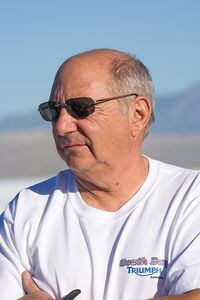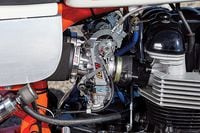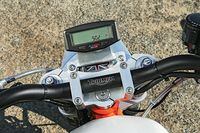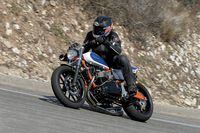No other motorcycle has formed the basis for so many variations on a theme as the Triumph Bonneville. California hot rods created in the 1960s and '70s for both on- and off-road use—including flat-track racing in the hands of men such as Gary Nixon, Dick Hammer, and Skip Van Leeuwen—were modern works of art. The bike you see here is a modern iteration of that idea, a brilliant new "tracker" chassis powered by a current-generation Bonneville engine, sans leaks, weaknesses, and trouble.
South Bay Triumph built this amazing machine, and Matt Capri is the man behind the company and the project. He's well acquainted with performance and racing. In 1973, he became BMW's western sales manager, wrenched on the R90S Superbike that Steve McLaughlin won the first-ever Daytona Superbike race on in 1976, and then in 1980 founded Luftmeister, the BMW tuning house that set several speed records with Capri-concocted turbocharged and normally aspirated boxers and four-cylinder "Flying Brick" K models.
With a track record for performance tuning and an ongoing Triumph dealership, it was inevitable Capri would turn his attention to Triumph's modern Bonneville. His customers have a choice of tune-ups, from a light makeover with bolt-on flat slides and a modified airbox, up to a big-bore motor with lots more performance than a stock Bonneville. One of those customers is London-based Triumph enthusiast Dave Martin, a vehicle recovery driver who's been a satisfied Capri client ever since purchasing his first modern Bonneville in 2003.
Dave made his first trip to the Bonneville Salt Flats in 2007 with the South Bay Triumph team to race on the salt aboard a moderately tuned Thruxton. That lit the fuse, and after carefully saving up the necessary money, he ordered the first South Bay Triumph Street Tracker to be built using the new competition flat-track chassis that Capri had commissioned, powered by an uprated Bonneville engine. "I wanted a proper Triumph with the kind of performance the Bonneville was famous for back in the 1960s," Dave says. "But I also wanted a one-of-a-kind motorcycle, and that's what Matt's delivered. I live a couple of miles from the Ace Café in London, and when I ride up there on a Friday night on the Tracker, I don't reckon there'll be too many others exactly like it!"
Rest assured it'll be unusual, in part because this is not just a repainted Bonneville. The Street Tracker's lightweight, twin-shock chassis weighs just 32 pounds including the fabricated box-section swingarm. This open-cradle, chrome-moly frame uses the Bonneville engine as a semi-stressed chassis member, which in turn allows the Tracker to weigh in at a remarkable 351 pounds with oil in the sump but no fuel in the 2.7-gallon aluminum fuel tank. Big savings come from Carrozzeria forged-aluminum wheels from Japan, which cut 20 pounds. The front is clamped in a 41mm KYB fork sourced from a 2004 Yamaha R6 and set at a 26.5-degree rake. Twin Öhlins shocks take up duty at the back.
To strengthen the parallel-twin motor to plug into this minimalist street tracker frame, Capri started with a 2003-model Bonneville engine and, while retaining the stock crankcases, flywheel, dual counterbalancers, and gearbox, fitted a welded-up, rebalanced crankshaft stroked by 6.3mm, still with Triumph's traditional 360-degree throws. The stock cylinders have been bored out to 92mm—the most they can support without cracking the cylinder liner, says Capri—and re-coated with Nikasil. The result is a boost from the stock 790cc to 988cc. New, 40-percent-lighter Arias pistons provide an 11.5:1 compression ratio (stock is 9.2:1), but the engine will still run on pump gas. Capri says this engine produces 106 rear-wheel horsepower on the same dyno that has a stock Bonnie making 61 hp. Torque is up to 80 pound-feet at 4,200 rpm, from 47 pound-feet in the stock machine.
It isn't just displacement and compression ratio boosting power; it's breathing, too. The Bonneville eight-valve cylinder head was ported by South Bay's Rick Kemp and then fitted with much larger valves that started life on the local Toyota dealer's parts shelf. "They're very well made and so large that you can easily cut them down to size and re-groove them," Capri says. South Bay Triumph's own high-lift camshafts with substantially longer duration and serious overlap are fitted, ground in the USA to Capri's spec. Finally, the head is fitted to the crankcases using a three-layer MSL head gasket that's rubber-coated to prevent leaks with the higher compression.
Twin 41mm Keihin FCR flat slides replace the stock 36mm carbs—this engine was pre fuel-injection, remember—bolted to CNC-machined billet manifolds and married to South Bay's airbox kit, which delivers a significantly freer-breathing package. The final part of the tuning equation is the Lubricor exhaust with separate twin stacked pipes running down the right of the bike. They provide a muscular exhaust note that isn't offensively loud.
Throwing a leg over the Street Tracker reveals the minimalist seat to be pretty comfortable, with the low but quite rearset location of the flip-up footrests delivering a great riding position. The Tracker's simply ideal for lane-splitting your way to the front of the line at stop lights, or zapping through freeway traffic at speed, or, best of all, carving canyons in the hills above the Pacific Ocean, where the Triumph's direct, quick steering and agile handling really come into their own.
To access this, just turn on the gas, forget about the choke on a summer day but instead blip the throttle a couple of times to prime the big Keihins, thumb the starter button, and get ready for the Triumph to thunder to life and settle to a lumpy 900-rpm idle. Matt Capri's got the balance factor just right on the stroker crank because vibration remains minimal even when you wind the throttle wide open in pursuit of the 8,500-rpm rev limiter, accompanied by the trademark flat, angry drone of a traditional British twin. That stroker crank seems unbelievably free-spinning, with a perfectly dialed-in throttle pickup that's immediate but not jerky, as flat slides can sometimes be. Fueling wasn't totally ideal low down, and it'd hiccup slightly and display some transmission snatch if I accelerated hard below 3,500 revs. But that's the threshold to serious performance, for the Triumph motor's mega midrange torque delivers truly impressive acceleration, as the front wheel lightens in either of the bottom two gears while the tach readout on the ultra nifty, British-made Acewell digital dash scoots up to the 7,500-rpm mark and beyond with unmistakable purpose.
Just one thing really needs a cure: The lower of the two exhaust megaphones is set much too low and grounds right out at even moderate angles of lean. "We got it fixed; we can lift it up an inch," Capri said when confronted with evidence of this in the form of a ground-in flat on my return to his shop.
Available at prices starting at $30,000, depending on specification, the South Bay Triumph Street Tracker is a classic California hot rod endowed with serious attitude—it's lean, lithe, accelerative, and potent, with few concessions to civility, staying true to its flat-tracker traditions. You know you want one.




















/cloudfront-us-east-1.images.arcpublishing.com/octane/HXOUJXQWA5HBHGRO3EMJIGFMVI.jpg)

/cloudfront-us-east-1.images.arcpublishing.com/octane/3TIWWRV4JBBOLDVGRYECVVTA7Y.jpg)
/cloudfront-us-east-1.images.arcpublishing.com/octane/KIX5O23D5NAIBGFXBN3327DKZU.jpg)
/cloudfront-us-east-1.images.arcpublishing.com/octane/7GJYDUIPXRGMTMQKN6ONYOLBOU.jpg)
/cloudfront-us-east-1.images.arcpublishing.com/octane/MUQLOVLL2ZDGFH25ILABNBXKTI.jpg)
/cloudfront-us-east-1.images.arcpublishing.com/octane/TNOU5DNE2BC57MFPMGN2EIDXAM.jpg)
/cloudfront-us-east-1.images.arcpublishing.com/octane/GTCXACQGJ5HAPDTGWUQKDEH44E.jpg)
/cloudfront-us-east-1.images.arcpublishing.com/octane/S35YGSEMEZB4BLTDJTSZPF4GLA.jpg)
/cloudfront-us-east-1.images.arcpublishing.com/octane/5UOT6HPX2JFMRJAX6EH45AR4MQ.jpg)
/cloudfront-us-east-1.images.arcpublishing.com/octane/OKWOJWAKP5EP3OACCRRWPCIX2Q.jpg)
/cloudfront-us-east-1.images.arcpublishing.com/octane/2WF3SCE3NFBQXLDNJM7KMXA45E.jpg)
/cloudfront-us-east-1.images.arcpublishing.com/octane/G4MG6OUCJNBSHIS2MVVOTPX65E.jpg)
/cloudfront-us-east-1.images.arcpublishing.com/octane/IIGGWFOTOJGB7DB6DGBXCCMTDY.jpg)
/cloudfront-us-east-1.images.arcpublishing.com/octane/QSTCM6AVEZA5JJBUXNIQ3DSOF4.jpg)
/cloudfront-us-east-1.images.arcpublishing.com/octane/U4I7G625B5DMLF2DVIJDFZVV6M.jpg)
/cloudfront-us-east-1.images.arcpublishing.com/octane/B6XD6LS6IVCQPIU6HXDJSM3FHY.jpg)
/cloudfront-us-east-1.images.arcpublishing.com/octane/ICL63FEDDRDTTMINYICCEYGMDA.jpg)
/cloudfront-us-east-1.images.arcpublishing.com/octane/FCGZHQXRBZFLBAPC5SDIQLVF4I.jpg)
/cloudfront-us-east-1.images.arcpublishing.com/octane/WNOB6LDOIFFHJKPSVIWDYUGOPM.jpg)

/cloudfront-us-east-1.images.arcpublishing.com/octane/X33NU3E525ECRHXLNUJN2FTRKI.jpg)
/cloudfront-us-east-1.images.arcpublishing.com/octane/6KKT5NNL2JAVBOXMZYS5ZO76YA.jpg)
/cloudfront-us-east-1.images.arcpublishing.com/octane/J5RKG5O455GMPGQRF2OG6LRT7A.jpg)